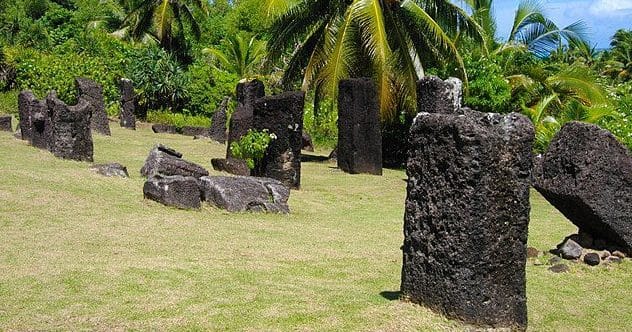History isn’t just something we read about in books; it’s etched into the very fabric of our world. Across the globe, there are places where the past isn’t just a memory but a tangible presence. These locations offer a direct window into events and lives long gone, allowing us to connect with bygone eras in a profound way. Journey with us as we explore ten incredible places that still bear the undeniable evidence of history.
10. Dinosaur Dance Floor
Imagine giants roaming the Earth! While dinosaur bones have been found for centuries, a site along the Arizona-Utah border offers something truly special. Over 1,000 dinosaur footprints, including those from mothers and their young, are imprinted in what’s now Vermilion Cliffs National Monument. Researchers aptly named it the “dinosaur dance floor.”
This ancient oasis attracted large groups of these massive creatures. Beyond footprints, rare dinosaur tail-drag marks also paint a picture of a time when this desert area experienced wetter periods. These physical indentations serve as direct proof of dinosaur activity, telling us more than just bones can about how they lived and moved.
9. Black Tears
December 7, 1941, is a date seared into history. The attack on Pearl Harbor in Hawaii dramatically pulled the United States into World War II. Today, visitors to the Pearl Harbor Aviation Museum can still see bullet holes and bomb craters in hangars, stark reminders of that fateful day.
The most poignant evidence, however, is the USS Arizona Memorial. The battleship, with 1,102 men still entombed within, lies submerged. After being struck by a massive bomb, the Arizona burned for nearly three days. Even now, oil leaks from the ship, forming shimmering slicks on the water’s surface. These are known as “black tears,” a continuous, somber testament to the tragedy and its lasting impact.
8. Hominin Fossil Sites
Scientists believe Africa is the birthplace of humankind. More than 2.5 million years ago, in what is now South Africa, early hominins faced daily dangers. In 1924, paleontologist Raymond Dart discovered a remarkable fossil skull at Taung. Initially ape-like, closer study revealed it belonged to a young hominin child who walked upright, later named the “Taung Child.”
This discovery, and later finds like an adult pelvis from Australopithecus africanus in the Sterkfontein Caves, confirmed upright walking. Hundreds of hominin fossils have since been unearthed in the region, leading UNESCO to declare it a World Heritage site known as the “Cradle of Humankind.” These bones are direct evidence of our ancient ancestors.
7. Earthquake of Biblical Proportions
Ancient texts, including the biblical books of Amos, Zechariah, and Ezekiel, describe a powerful earthquake in the 8th century BC. The Roman-Jewish historian Josephus also wrote of a quake during King Uzziah’s reign. For a long time, this was primarily textual evidence, but archaeology has provided physical proof.
Excavations at the ancient city of Megiddo revealed tilted walls, fractured stones, and dipping floors dating to this period. More recently, in Jerusalem’s City of David National Park, a layer of destruction was found containing shattered pottery and collapsed walls, consistent with a major earthquake. This archaeological evidence strongly suggests that the earthquake described in ancient writings was a very real and devastating event.
6. The Plagues of Egypt
The biblical story of the plagues that struck Egypt is well-known. While some view these tales as purely allegorical, archaeological and scientific findings suggest that real environmental events might have inspired these accounts, particularly in the ancient city of Pi-Rameses.
Evidence points to a severe drought that could have discolored the Nile River, matching the description of water turning to blood. This drought likely forced frogs from the river, leading to their demise and a subsequent explosion of insect populations, which in turn could have spread disease. Furthermore, ash deposits from the massive Thera volcanic eruption (around 1628 BC) found in the Nile region could explain the described plague of hail and fire.
5. A Horrific Time in History
In 1692, the small community of Salem Village in Colonial America was consumed by “witch fever.” Over seven months, more than 150 people were arrested for witchcraft, leading to twenty executions and five deaths in prison. This dark chapter was fueled by accusations, often from young girls, and the acceptance of “spectral evidence” in court.
Today, the Salem Village Historic District in Danvers, Massachusetts, still holds tangible links to this tragic period. More than a dozen houses from the witch trials era stand, including the Rebecca Nurse Homestead. Rebecca Nurse was convicted and hanged as a witch. Her home, now a historical landmark, allows visitors to step back into a period of intense fear and injustice, offering a physical connection to the lives affected.
4. Ancient Tsunami
About 3,800 years ago, a colossal tsunami devastated the Chilean coastline. This event was so catastrophic that it forced local hunter-gatherer populations to abandon coastal areas and move inland for roughly a thousand years. Researchers discovered evidence of this ancient disaster in the Atacama Desert.
The team found distinctive sediment layers, characteristic of a tsunami, spread over a vast area. They also uncovered stone houses with walls collapsed inward, a clear sign of being struck by a massive wave. The coastline of Chile is prone to earthquakes, and it’s believed this tsunami was triggered by a quake likely similar in magnitude to the 9.5 Valdivia earthquake of 1960, the largest ever recorded.
3. Badrulchau Monoliths
On Babeldaob Island in Palau stand the Badrulchau Stone Monoliths, the largest and oldest archaeological site in the country. These 52 basalt stone monuments, some with faces carved into them, date back to around AD 161. Their purpose remains a subject of intrigue and local legend.
Experts suggest these stones might have been pillars for an enormous Palauan meeting house, or bai. Legend says this structure was built by gods who abandoned their work at a false dawn. If these monoliths are indeed remnants of a bai, it would have been the largest ever constructed. These imposing stones are a physical puzzle, hinting at sophisticated ancient construction and rich oral traditions.
2. The World’s First Animal
What was the earliest animal on Earth? Preserved fatty molecules in a flat, rippled fossil provided a groundbreaking answer. The fossil belonged to Dickinsonia, an organism that lived in the oceans around 558 million years ago, millions of years before the Cambrian explosion, a period of rapid species diversification.
Dickinsonia, growing up to 1.4 meters long, puzzled scientists for decades. Was it a primitive animal, a single-celled organism, or something else entirely? The key came from Ediacaran fossils found on the shores of the White Sea, with their organic matter remarkably preserved. Analysis showed Dickinsonia fossils contained 93% cholesterol, a type of fat indicative of animal life, confirming its status as one of Earth’s first known animals.
1. Iron Age Temples
Navan Fort, near Armagh in Northern Ireland, is steeped in legend as a site once hosting the kings of Ulster. Traditionally, it was believed to have been abandoned around 95 BC. However, recent archaeological discoveries have rewritten its history, revealing a much longer period of occupation.
Using remote-sensing technology and geophysical surveys, archaeologists found evidence of an enormous Iron Age temple complex, including residences. These non-invasive techniques detected soil variations, allowing researchers to map ancient structures hidden beneath the surface. This complex, one of the largest and most complex found in Europe, suggests Navan Fort’s significance extended well into the medieval era. The hidden structures await excavation, promising more insights into this ancient royal site.
The Earth is a living museum, whispering tales of its past to those who know where to look. These ten sites are just a glimpse into the countless locations where history’s evidence remains tangible, offering us profound connections to the events and beings that shaped our world. Visiting or learning about such places reminds us that the past is never truly gone; it’s imprinted on the landscape, waiting to be discovered and understood.
Which of these historical sites fascinates you the most? Do you know of other places that bear incredible evidence of the past? Share your thoughts and discoveries in the comments below!










